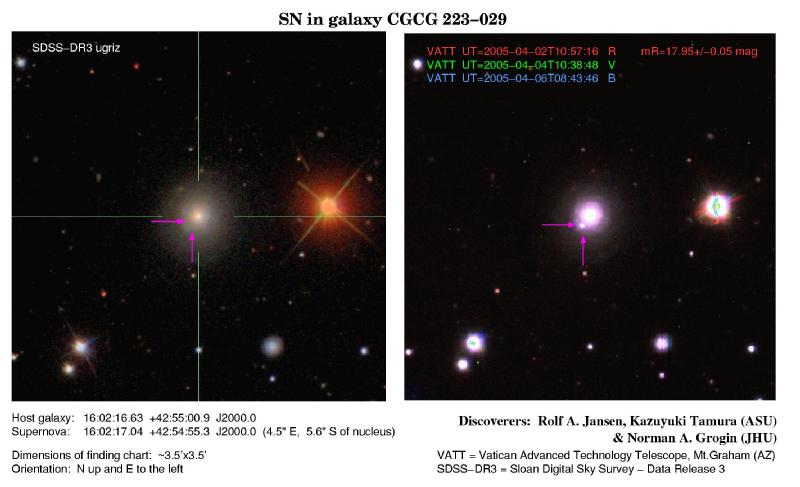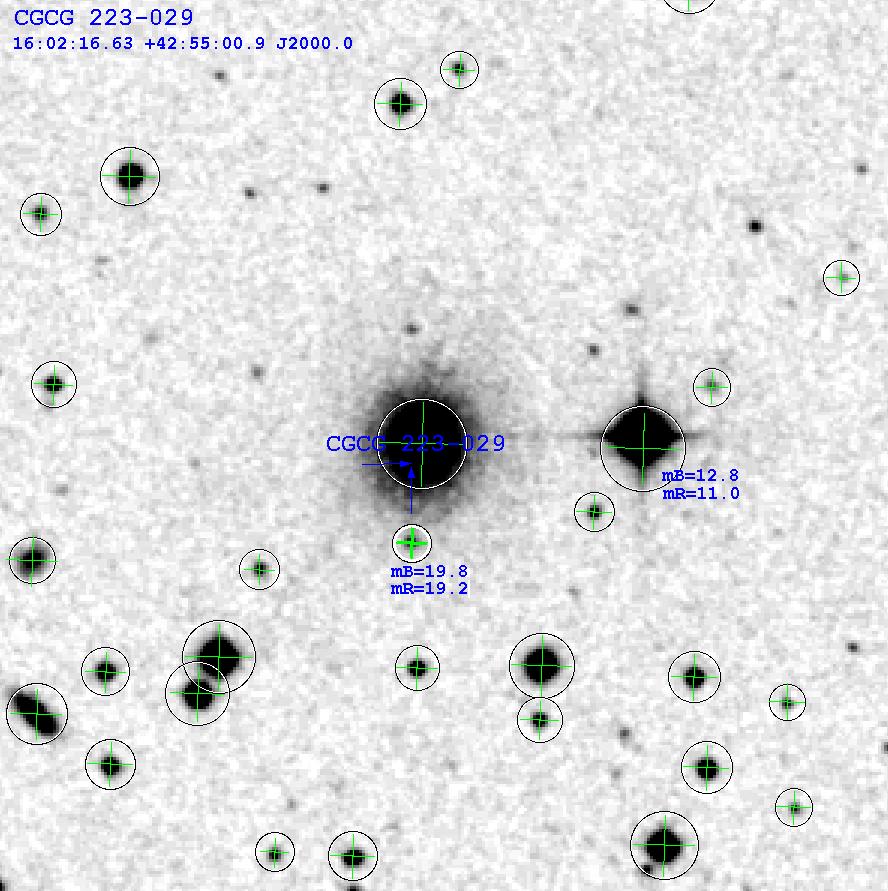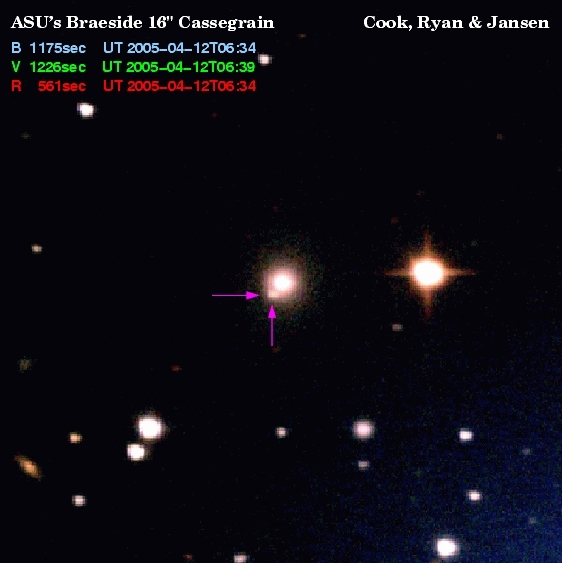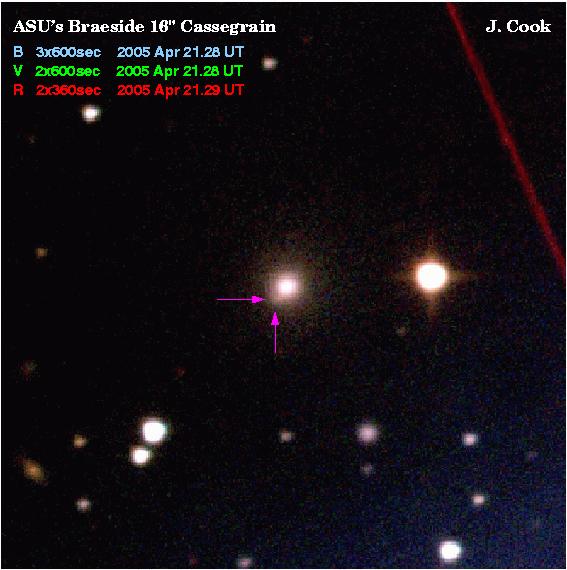
ASU Astronomers discover Supernova in nearby void galaxy CGCG 223-029
ASU astronomers
R.A. Jansen and
K. Tamura in collaboration
with N.A. Grogin (Johns Hopkins University) today (April 2) reported their
discovery of an apparent supernova in UBVRI images of star-bursting early-type spiral galaxy
CGCG 223-029 (R.A.=16h
02m16s.63,
Decl.=+42°55'00.9" J2000.0), obtained with the CCD camera on the
1.8 m
Vatican Advanced Technology Telescope (VATT) of the
Mt.Graham International Observatory,
AZ.
Jansen first found the conspicuous point-like object on 2005 April 02.46 UT
in two 300 sec R filter CCD images. It is located 4.5" East
and 5.6" South of the nucleus, i.e., at R.A.=16h
02m17s.04,
Decl.=+42°54'55.3" J2000.0. Jansen and Tamura confirmed the object to
be stationary on subsequent nights: 2005 April 04.4, 2005 April 05.4,
2005 April 06.4 and 2005 April 07.5 UT.
Both a Sloan Digital Sky Survey - Data
Release 3 finding-chart image (shown above, left panel) and a
F.L. Whipple
Observatory
48" telescope
R-filter CCD image obtained by Grogin on 1995 May 31.4 UT show the
object to be absent from these earlier data. Via subtraction of the
48" R image, the R magnitude of the supernova on 2005 April
02.46 UT was measured as 17.95 ± 0.05 mag.
Spectroscopic and photometric follow-up of this supernova is encouraged. For
this purpose a printable PDF version of finding chart and discovery image
above is available here (~98 kB).
|
In the picture to the right, USNO stars are indicated on a DSS2 image centered
on the SN host galaxy CGCG 223-029. Note the bright (mB~12.8
mag) star about 74" almost due West from the galaxy nucleus.
(Click on the image to enlarge)
|

|

|
The picture at the left is a color composite of B, V and R
filter images obtained by ASU graduate students Jason Cook and Russell Ryan
on 2005 April 12.3 UT using the CCD camera at the
Braeside 16" Cassegrain Telescope.
Although the resolution (FWHM) is only ~3 arcsec, the supernova is clearly
detected.
(Click on the image to enlarge.)
|
|
Per IAU Circular 8512, the supernova has received the designation
SN 2005bk.
SUPERNOVA 2005bk IN MCG +07-33-27
R.A. Jansen and K. Tamura, Arizona State University; and N.A.
Grogin, Johns Hopkins University, report their discovery of an
apparent supernova in UBVRI CCD images obtained with the 1.8-m
Vatican Advanced Technology Telescope atop Mt. Graham. Jansen
first found the conspicuous point-like object at R = 17.95 +/- 0.05
on two 300-s R-band images taken on Apr. 2.46 UT, it and was
confirmed on images taken by Jansen and Tamura on Apr. 4.4, 5.4,
6.4, and 7.5. The new object is located at R.A. = 16h02m17s.04,
Decl. = +42o54'55".3 (equinox 2000.0), which is 4".5 east and 5".6
south of the center of the nucleus of MCG +07-33-27. Nothing is
visible at this location on a Sloan Digital Sky Survey image or on
an R-band CCD image obtained by Grogin on 1995 May 31.4 with the
F. L. Whipple Observatory 1.2-m telescope (limiting mag R
approximately 21.3). There is a nearby bright (red mag about 11,
blue mag about 13) foreground star with position end figures
09s.94, 04".6.
|
In IAU Circular 8514, M. Ganeshalingam and collaborators from
the University of California at Berkeley report that inspection of CCD
spectra, obtained on April 17 UT with the Shane 3 m
telescope at Lick Observatory and spanning the range
3,300Å—10,000Å, show that SN 2005bk is of type
Ic, similar to SN 1994I (Fillipenko et al. 1995, ApJ 450, L11)
about one week past maximum light. This would imply that Jansen, Tamura
& Grogin discovered the supernova a few days before maximum light.
|
|

|
On 2005 April 21.3 UT, Jason Cook revisited supernova 2005bk using the
Braeside 16" telescope and CCD camera. At left is a color composite
constructed from the B, V and R images by Rolf Jansen.
Seeing conditions during these observations were poor, but the supernova is
still detectable as a slight extension toward the southeast.
(Click on the image to enlarge.)
|
More information and images will be posted on this page as they become
available.
|
